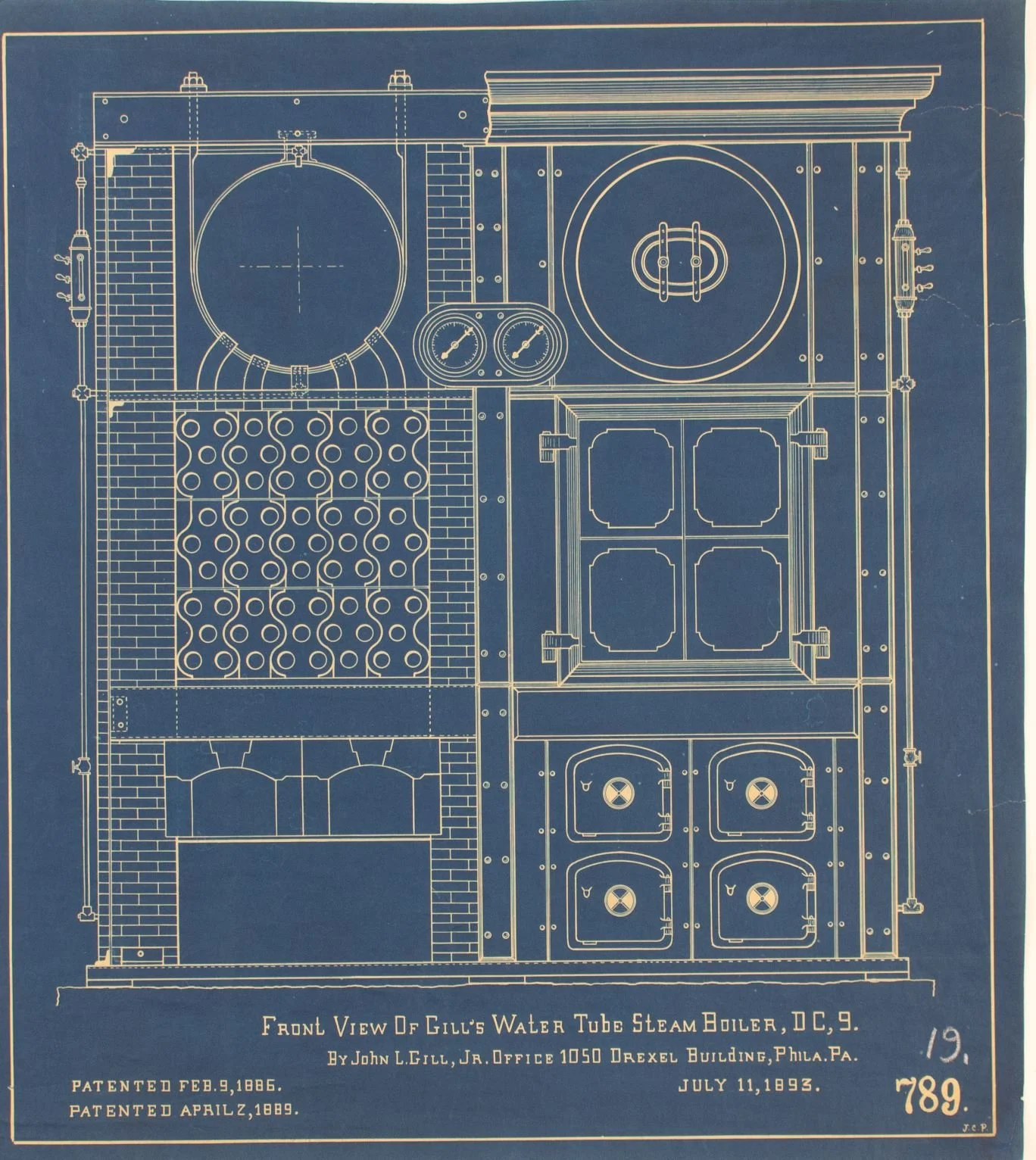In September 2021, the Municipal Archives received the very welcome notice of grant funding from the National Park Service Save America’s Treasures (SAT) program to preserve the Brooklyn Bridge Drawings Collection. Established in 1998, the SAT celebrates the country’s premier cultural resources with grant support to preserve properties listed in the National Register of Historic Places and for projects involving collections that document significant places. The Institute for Museum and Library Services administers the SAT-funded projects.
Caisson in Position, Brooklyn Side, 1869, Washington A. Roebling, Brooklyn Bridge Drawings Collection. NYC Municipal Archives.
The three-year SAT grant award to the Municipal Archives is the latest in a series of special projects and artistic endeavors featuring the collection—exhibitions, documentary films, books—all generated by the enduring fascination with and affection for the Brooklyn Bridge.
Like the bridge itself, the drawings have been the focus of great interest since their “discovery” in a carpenter’s shop in 1969. The late writer David McCullough’s account of how they were found remains the definitive story. Appearing in American Heritage magazine, in December 1979, McCullough’s article describes how a young civil engineer, Francis P. Valentine, working for the City’s Department of Transportation had been dispatched to a carpenter’s shop beneath the Williamsburg Bridge in search of a drawing needed to repair the Brooklyn Bridge. According to McCullough, “What he found, what he saw the morning he first walked into the shop, was one of the most remarkable treasures in the whole history of the building art, a collection like none other, totaling some ten thousand original blueprints and drawings….” Disordered, and covered in dust and filth, it was apparent that their value “as magnificent works of art, not to mention historic documents of great consequence, had thus far failed to dawn on anyone of authority.”
Plan of the Brooklyn Caisson, Brooklyn Bridge Drawings Collection. NYC Municipal Archives.
It took a few more years, but that changed. McCullough’s article tells the saga. It began with an exhibition of some of the most spectacular items at the Whitney Museum of American Art, in May 1976—“a huge success,” according to McCullough. The story continues: “The Municipal Archives and the Brooklyn Museum... each commenced to lay claim to the collection.” Ultimately, the Municipal Archives’ assertion that the drawings were city property won out. The Archives received the collection from the Department of Transportation in 1976.
Interest in the collection was further sparked by Ken Burns’ award-winning documentary film, The Brooklyn Bridge. The newly established Department of Records & Information Services facilitated access to the drawings and served as the institutional sponsor for the film, released in 1981.
The drawings played a central role in the City’s celebration of the Brooklyn Bridge centennial in May 1983. The “Great East River Bridge” exhibition at the Brooklyn Museum that year featured items from the collection. The accompanying book, which reproduced many of the most iconic drawings, remains the ultimate authority.
Front View of Gill’s Water Tube Steam Boiler, 1893, Brooklyn Bridge Drawings Collection. NYC Municipal Archives.
After transfer to the Municipal Archives, the collection was prioritized for conservation, cataloging and reformatting. The National Endowment for the Humanities, and several foundations provided funding for the first round of processing. The work took place between 1979-1983 when the Archives was located in the Tweed Courthouse. The Brooklyn Bridge drawings, along with the Central Park drawings—the Archives’ other collection documenting a great nineteenth-century engineering achievement—were moved to 31 Chambers Street in 1984.
More recent collection surveys conducted by conservators at the Municipal Archives revealed that many of the Brooklyn Bridge drawings still required conservation treatment; and in some instances, housing conditions were not ideal.
Grating and Basin Head for Subdrainage of Railways, Brooklyn Approach, Brooklyn Bridge Drawings Collection. NYC Municipal Archives.
In 2006 and 2019, conservators undertook projects to treat and rehouse the oversized drawings with support from the New York State Library. During the 2006 project, more than 500 oversized drawings were stabilized and rehoused, either rolled onto archival tubes or stored flat. In December 2020, conservators successfully completed the treatment of 78 of the largest encapsulated bridge drawings, which range in size from five to more than 15 feet in length. For the Record featured this work in Treating the Brooklyn Bridge Drawings, Phase One and Conserving Central Park and Brooklyn Bridge Plans
The new award from the SAT program funds a three-year project that will complete the treatment and stabilization of the at-risk Brooklyn Bridge drawings and make the collection fully accessible and preserved for the future. The pandemic delayed commencement of the project, but it is now fully-staffed and well underway. Look for future articles detailing project progress.
Murphy Smokeless Furnace Applied to Two Babcock and Wilcox Boilers, Brooklyn Bridge Drawings Collection. NYC Municipal Archives.
In the meantime, interest in the Brooklyn Bridge and the drawings continues unabated. This past week, the Municipal Archives hosted film-makers from German National Television making yet another documentary about the Brooklyn Bridge and its builders. Turning again to McCullough, perhaps his beautiful prose helps explain the enduring fascination with the drawings:
“But then, in the last analysis, one comes to something in these drawings that is impossible to catalogue... and it is this that matters most. It is the incredible care and concentration you feel in even the least of these drawings, the pride, the obvious love—love for materials, love for elegance in design, love of mathematics, of line of light and shadow, of majestic scale, and yes, love of drawings—this passion in combination with an overriding insistence on order, on quality, that we of this very different century must inevitably stand in awe before, however many men we put on the moon. You feel what these people felt for their work and you can’t help but be drawn to them.”

